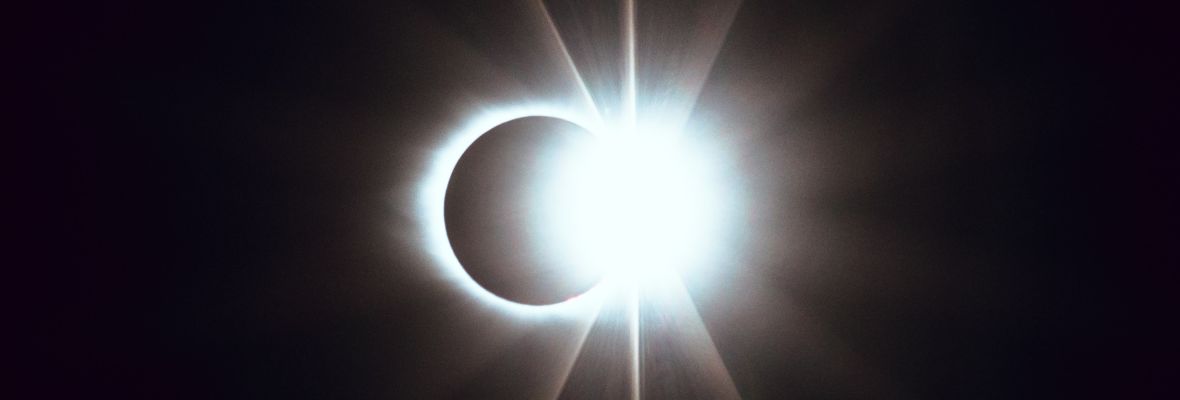We are thrilled to announce the official launch of our new website, Polar Latitudes Expeditions. Discover more in our latest news update, and visit our new website polar-latitudes.com.
Totality is a special experience, but exactly how often does the White Continent go dark? Only a very few people (though lots of penguins) have experienced a total solar eclipse in Antarctica. Will you be one of them?
Only a very few people (though lots of penguins) have experienced a total solar eclipse in Antarctica. Will you be one of them?
Just after 7 a.m. on Saturday, 4 December, 2021 the shadow of the Moon will surge across Antarctica, plunging the Ocean Victory and Ocean Atlantic into a rare kind of darkness. For between a minute and 1 minute 40 seconds the Sun will be blocked by the Moon to cause a totality along a path about 300 miles wide, with guests of Albatros Expeditions able to remove their solar eclipse glasses as they’re bathed in a deep twilight. If the sky is clear the celestial alignment will be visible low on the horizon as a halo around the eclipse as the Sun’s bright, white outer atmosphere – its corona – becomes visible to the naked eye.
It could be the most incredible total solar eclipse ever seen. These grand sights occur only when a New Moon moves precisely between the Sun and the Earth. It’s a quirk of nature since the Moon is roughly 400 times smaller than the Sun, but 400 times closer to Earth, which is why the Sun and the Moon look the same size in our sky.
Despite that celestial coincidence, total solar eclipses remain rare because the Moon’s orbit is not aligned with the path of the Sun through our sky, something called the ecliptic (the clue is in the name, right?). If the two paths were aligned we would get solar eclipses every month. However, the Moon’s orbital path around Earth does intersect with the ecliptic. When that happens during a New Moon we get a solar eclipse, and when it occurs at Full Moon, a lunar eclipse results. One always follows the other; when the Moon is in the right place to cause one kind of eclipse, two weeks later it’s still in the right place. This is an eclipse season. There’s a partial lunar eclipse on 18 November, 2021.
Between two and five solar eclipses occur every year – many of them partial – while a total solar eclipse occurs roughly every 18 months, on average. However, no one totality is related to the next. To understand where and when they will occur you have to appreciate the solar saros cycle, a repeating pattern of the Sun, Moon and Earth that throws near-identical shadows across space every 18 years, 11 days and 8 hours.
There are 40 solar saros cycles currently causing eclipses, but Antarctica has its own. Saros 152 began causing total solar eclipses in 1967 and will continue to do so until the year 2490. By then it will have created 27 total solar eclipses, each one at almost the same latitude, every 18 years, 11 days and 8 hours. That’s 223 orbits of the Moon around the Earth. However, while the timing of the shadow of the Moon created by solar saros 152 is predictable, exactly where it falls every 8 years, 11 days and 8 hours depends on Earth’s rotation. So while the latitude remains roughly the same for each eclipse in a saros series – and the duration of totality is similar – the longitude changes.
The events of 4 December, 2021 will be the fourth total solar eclipse in Antarctica, and by far the most experienced by humans so far. It’s unlikely that anyone experienced totality over the Southern Ocean on 2 November, 1967. There are no records of eye-witnesses, nor for the following eclipse in solar saros 152 exactly 8 years, 11 days and 8 hours later on 12 November, 1985, which barely touched the Antarctic continent. The most recent total solar eclipse in Antarctica was more widely experienced. Occurring on 23 November, 2003, some eclipse-chasers observed from plane flown from Punta Arenas, Chile and Melbourne, Australia, while other journeyed for a month on a Russian icebreaker from Port Elizabeth, South Africa, to experience totality on Antarctica’s remote eastern ice shelf. The next one, on 15 December, 2039, is similarly remote and probably out of reach of cruise ships.
So unless you were there 18 years, 11 days and 8 hours previously, the total solar eclipse on 4 December, 2021 is almost certainly a once in a lifetime opportunity to glimpse the glory of totality in Antarctica’s unique environment.
Jamie Carter is editor of WhenIsTheNextEclipse.com and will be lecturing onboard Albatross Expeditions’ Ocean Victory.



